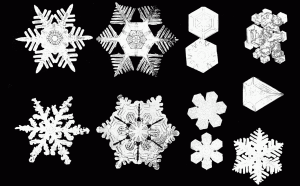
Every snowflake is different!
goes the saying. This can be used to fight counterfeiting of physical objects.
Assume we have a method to create a physical unique structure. And the method is so difficult to control that we are not able to recreate the same structure twice (snowflakes may be an example of this). Let’s call this a physical unique ID (puid).
Assume furthermore, that we have some method to reliably digitalize the structure into some fingerprint (the process must be tolerant enough to have a low error rate but strict enough such that it is still impossible to produce two puids that generate the same fingerprint).
To protect let’s say a banknote we attach the puid together with a digital signature of its fingerprint (this can be done by RFID or QR-code for example). To check the genuineness of the note one has to digitalize the puid and verify that the signature matches to the fingerprint. Of course the signature should also cover other data of the note – in particular the face value so that valid signatures cannot be reused on higher notes.
What’s the advantage over current technologies? Currently we try to carefully control the process but with proper equipment and knowledge the process can be reproduced. By taking a process nobody controls sufficiently and digital cryptography we should gain additional security.
Tell me who else came up with this idea or why it does not work. What could be a good puid-process?
Update:
I meanwhile found Physical unclonable function and Dust Identity.